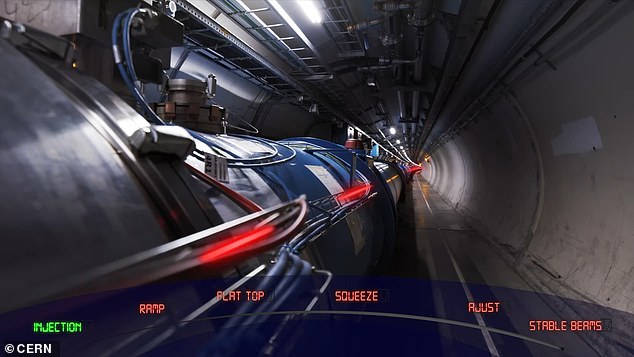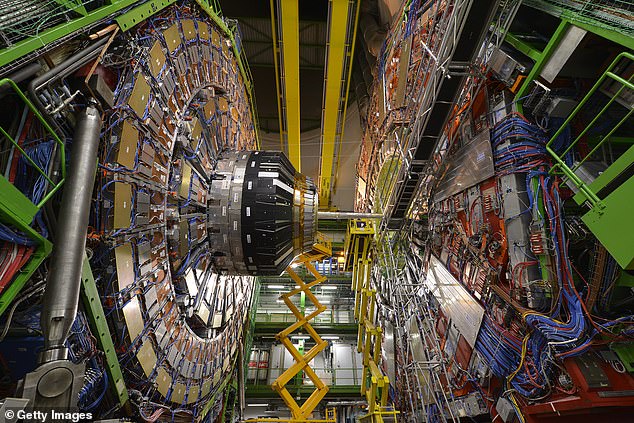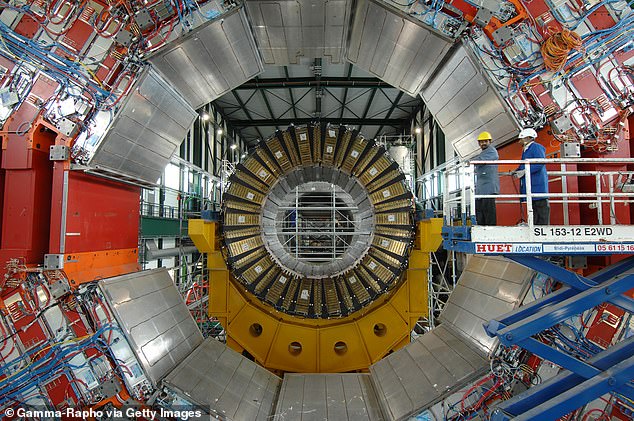CERN tests the world’s most powerful particle accelerator – dubbed ‘the Big Bang machine’ – by colliding particles with each other at a speed of almost 1000 million kilometers per hour
The world’s largest and most powerful particle accelerator smashed protons together on Friday, bringing scientists closer to understanding the Big Bang.
CERN researchers placed three beams of protons in the Large Hadron Collider (LHC) and shot them through a 27-kilometer-long tunnel at nearly the speed of light to reconstruct what happened 13.8 billion years ago.
The LHC smashed the particles together with unprecedented energy in an attempt to create massive new particles that secretly power our universe.
LHC will keep the beams moving until Monday, when the team will capture the energy for analysis – and more collision tests are planned until October.
Arnaud Marsollier, head of media at CERN, told DailyMail.com: ‘This is absolutely exciting, I can tell you that scientists are in the starting blocks to receive their wave of data for this year and improve our understanding of nature .
‘We can’t wait to look at the Higgs boson in more detail and continue searching for dark matter with our Big Bang machine!’
The world’s largest and most powerful particle accelerator smashed protons together on Friday, bringing scientists closer to understanding the Big Bang
The CERN team began preliminary tests last month by sending billions of protons around the LHC’s ring of superconducting magnets to boost their energy and ensure the $4 billion machine was in working order.
The accelerator is located 90 meters underground on the border of France and Switzerland and went live for the first time on September 10, 2008.
The LHC works by smashing protons together to break them apart and discover the subatomic particles contained within, and how they interact – scientists use protons because they are heavier particles.
The weight ensures a much lower energy loss per turn through the accelerator than other particles such as photons.
‘What we do at CERN is do particle physics with accelerators like the LHC, and this has little to do directly with astrophysics, although particle physics and astrophysics can answer similar key questions with different approaches and instruments, for example in the study of dark regions. matter, one of the most fascinating mysteries for science,” Marsollier said.
The LHC goes into hibernation every year during the winter months and then starts up again the following spring – and that happened on March 8.

CERN researchers placed three beams of protons in the Large Hadron Collider (LHC) and shot them through a 27-kilometer-long tunnel at nearly the speed of light to reconstruct what happened 13.8 billion years ago

The LHC works by smashing protons together to break them apart and discover the subatomic particles contained within, and how they interact – scientists use protons because they are heavier particles.
“Restarting such an accelerator requires a full commissioning process to ensure that all equipment is working properly,” Marsollier explains.
“Now that all checks have been completed, the LHC is ready to provide particle collisions for the LHC experiments.”
The restart saw radiates the beam circle within the ring of the LHC, allowing more time to accelerate the particle beam so that higher energy can be achieved.
Scientists watched in amazement as the beam circled the accelerator in less than 20 minutes, proving the accelerator was ready for Friday’s exciting event that saw the particles race around the ring 11,245 times per second.
About three sets of beams were injected into the LHC today and the energy of the protons was increased to different levels in a few minutes.
The goal was to achieve 6.8 tera-electron volts (TeV) – one TeV is about the same energy released by a flying mosquito – a record that has never been achieved in a particle accelerator.
While that may seem like a very small amount of energy, it is an incredible amount of energy for a single proton.
The speed was only seven miles per hour less than the speed of light.
CERN researchers were supposed to collide particles with each other on the day of the solar eclipse, April 8, but instead they stepped up the experiment.

About three sets of beams were injected into the LHC today and the energy of the protons was increased to different levels in a few minutes
And on Friday they saw the first stable beams – the goal of CERN.
“To obtain stable beams, the circulating beams must then be ‘squeezed’ and adjusted using the LHC magnets,” researchers shared in the announcement.
‘This involves making the beams narrower and more centered in their path, making it more likely that a large number of collisions will occur in the detectors.
‘Only after the squeezing and adjusting is completed can stable beams be declared and experiments around the LHC begin collecting data.’
About three sets of beams were injected into the LHC on Friday and the energy of the protons was increased to different levels in a few minutes.
The goal was to achieve 6.8 tera-electron volts (TeV) – one TeV is about the same energy released by a flying mosquito – a record that has never been achieved in a particle accelerator.
While that may seem like a very small amount of energy, it is an incredible amount of energy for a single proton.
“The ‘Dump on Monday’ means that if all goes well, the team of operators will keep the beams running all weekend and dump them on Monda early, Marsollier said.
“If we have beams, we try to keep them for as long as possible if the quality of the collisions and the data is good.
‘Then access means that they will take the opportunity to fix something before the next refueling. That is a standard process, we need access regularly. ‘
The purpose of LHC is to let scientists test predictions of various particle physics, including measuring the properties of the Higgs boson, or God boson, which has been a missing piece in their attempts to understand how the universe works.
Scientists believe that a fraction of a second after the Big Bang, which created the universe, an invisible energy field called the Higgs field was created.
As particles moved through the field, they picked up mass, giving them size and shape and allowing them to form the atoms that make up you, everything around you, and everything in the universe.
This was the theory proposed in 1964 by former grammar school boy Professor Higgs, and which has now been confirmed.
And although the particles decayed almost immediately during the LHC experiment, scientists found that they left a footprint that revealed their existence.
